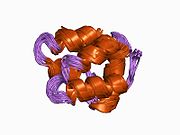Biology:Annexin A1
Annexin A1, also known as lipocortin I, is a protein that is encoded by the ANXA1 gene in humans.[1]
Function
Annexin A1 belongs to the annexin family of Ca2+-dependent phospholipid-binding proteins that have a molecular weight of approximately 35,000 to 40,000 Dalton and are preferentially located on the cytosolic face of the plasma membrane. Annexin A1 protein has an apparent relative molecular mass of 40 kDa with phospholipase A2 inhibitory activity.[2]
Clinical significance
Effect on innate and adaptive immunity
Glucocorticoids (such as budesonide, cortisol, and beclomethasone) are a class of endogenous or synthetic anti-inflammatory steroid hormones that bind to the glucocorticoid receptor (GR), which is present in almost every vertebrate animal cell. They are used in medicine to treat diseases caused by an overactive immune system, including allergies, asthma, autoimmune diseases, and sepsis.[3] Because they suppress inflammatory pathways, long-term use of glucocorticoid drugs can lead to side-effects such as immunodeficiency and adrenal insufficiency.
The main mechanism of glucocorticoids' anti-inflammatory effects is to increase the synthesis and function of annexin A1.[4] Annexin A1 both suppresses phospholipase A2, thereby blocking eicosanoid production, and inhibits various leukocyte inflammatory events (epithelial adhesion, emigration, chemotaxis, phagocytosis, respiratory burst, etc.). In other words, glucocorticoids not only suppress immune response, but also inhibit the two main products of inflammation, prostaglandins and leukotrienes. They inhibit prostaglandin synthesis at the level of phospholipase A2 as well as at the level of cyclooxygenase/PGE isomerase (COX-1 and COX-2),[5] the latter effect being much like that of NSAIDs, potentiating the anti-inflammatory effect.
In resting conditions, human and mouse immune cells such as neutrophils, monocytes, and macrophages contain high levels of annexin A1 in their cytoplasm. Following cell activation (for example, by neutrophil adhesion to endothelial-cell monolayers), annexin A1 is promptly mobilized to the cell surface and secreted. Annexin A1 promotes neutrophil detachment and apoptosis, and phagocytosis of apoptotic neutrophils by macrophages. On the other hand, it reduces the tendency of neutrophils to penetrate the endothelium of blood vessels. In vitro and in vivo analyses show that exogenous and endogenous annexin A1 counter-regulate the activities of innate immune cells, particularly extravasation and the generation of proinflammatory mediators, which ensures that a sufficient level of activation is reached but not exceeded.[4]
Annexin A1 has important opposing properties during innate and adaptive immune responses: it inhibits innate immune cells and promotes T-cell activation. The activation of T cells results in the release of annexin A1 and the expression of its receptor. This pathway seems to fine-tune the strength of TCR signalling. Higher expression of annexin A1 during pathological conditions could increase the strength of TCR signalling through the mitogen-activated protein kinase signalling pathway, thereby causing a state of hyperactivation of T cells.[4]
Inflammation
Since phospholipase A2 is required for the biosynthesis of the potent mediators of inflammation, prostaglandins, and leukotrienes, annexin A1 may have potential anti-inflammatory activity.[2]
Glucocorticoids stimulate production of lipocortin.[6] In this way, synthesis of eicosanoids are inhibited.
Cancer
Annexin A1 has been of interest for use as a potential anticancer drug. Upon induction by modified NSAIDS and other potent anti-inflammatory drugs, annexin A1 inhibits the NF-κB signal transduction pathway, which is exploited by cancerous cells to proliferate and avoid apoptosis. ANXA1 inhibits the activation of NF-κB by binding to the p65 subunit.[7]
Leukemia
The gene for annexin A1 (ANXA1) is upregulated in hairy cell leukemia. ANXA1 protein expression is specific to hairy cell leukemia. Detection of ANXA1 (by immunocytochemical means) reportedly provides a simple, highly sensitive, and specific assay for the diagnosis of hairy cell leukemia.[8]
Breast cancer
Altered annexin A1 expression levels through modulation of the immune system effects the initiation and spread of breast cancer, but the association is complex and conclusions of published studies often conflict.[9]
Exposure of MCF-7 breast cancer cells to high physiological levels (up to 100 nM) of estrogen lead to an up-regulation of annexin A1 expression partially through the activation of CREB, and dependent on activation of the estrogen receptor alpha. Treatment of MCF-7 cells with physiological levels of estrogen (1 nM) induced proliferation while high pregnancy levels of estrogen (100 nM) induced a growth arrest of MCF-7 cells. Silencing of ANXA1 with specific siRNA reverses the estrogen-dependent proliferation as well as growth arrest. ANXA1 is lost in clinical breast cancer, indicating that the anti-proliferative protective function of ANXA1 against high levels of estrogen may be lost in breast cancer. This data suggests that ANXA1 may act as a tumor suppressor gene and modulate the proliferative functions of estrogens.[10]
Annexin A1 protects against DNA damage induced by heat in breast cancer cells, adding to the evidence that it has tumor suppressive and protective activities. When ANXA1 is silenced or lost in cancer, cells are more prone to DNA damage, indicating its unidentified diverse role in genome maintenance or integrity.[11] Annexin A1 has also been shown to be associated with treatment resistance. ARID1A loss activates annexin A1 expression, which is required for drug resistance (mTOR inhibitor or trastuzumab) through its activation of AKT.[12]
References
- ↑ "Cloning and expression of human lipocortin, a phospholipase A2 inhibitor with potential anti-inflammatory activity". Nature 320 (6057): 77–81. 1986. doi:10.1038/320077a0. PMID 2936963. Bibcode: 1986Natur.320...77W.
- ↑ Jump up to: 2.0 2.1 "Entrez Gene: ANXA1 annexin A1". https://www.ncbi.nlm.nih.gov/sites/entrez?Db=gene&Cmd=ShowDetailView&TermToSearch=301.
- ↑ "Antiinflammatory action of glucocorticoids--new mechanisms for old drugs". The New England Journal of Medicine 353 (16): 1711–1723. October 2005. doi:10.1056/NEJMra050541. PMID 16236742.
- ↑ Jump up to: 4.0 4.1 4.2 "Annexin A1 and glucocorticoids as effectors of the resolution of inflammation". Nature Reviews. Immunology 9 (1): 62–70. January 2009. doi:10.1038/nri2470. PMID 19104500.
- ↑ "Glucocorticoids inhibit prostaglandin synthesis not only at the level of phospholipase A2 but also at the level of cyclo-oxygenase/PGE isomerase". British Journal of Pharmacology 98 (4): 1287–1295. December 1989. doi:10.1111/j.1476-5381.1989.tb12676.x. PMID 2514948.
- ↑ "Glucocorticoid-and non-glucocorticoid induction of lipocortins (annexins) 1 and 2 in rat peritoneal leucocytes in vivo". British Journal of Pharmacology 108 (1): 66–72. January 1993. doi:10.1111/j.1476-5381.1993.tb13441.x. PMID 8428216.
- ↑ "Annexin 1 induced by anti-inflammatory drugs binds to NF-kappaB and inhibits its activation: anticancer effects in vitro and in vivo". Cancer Research 70 (6): 2379–2388. March 2010. doi:10.1158/0008-5472.CAN-09-4204. PMID 20215502.
- ↑ "Simple diagnostic assay for hairy cell leukaemia by immunocytochemical detection of annexin A1 (ANXA1)". Lancet 363 (9424): 1869–1870. June 2004. doi:10.1016/S0140-6736(04)16356-3. PMID 15183626.
- ↑ "Annexin A1 influences in breast cancer: Controversies on contributions to tumour, host and immunoediting processes". Pharmacological Research 119: 278–288. May 2017. doi:10.1016/j.phrs.2017.02.011. PMID 28212890.
- ↑ "Annexin-1 regulates growth arrest induced by high levels of estrogen in MCF-7 breast cancer cells". Molecular Cancer Research 7 (2): 266–274. February 2009. doi:10.1158/1541-7786.MCR-08-0147. PMID 19208747.
- ↑ "Annexin-1 protects MCF7 breast cancer cells against heat-induced growth arrest and DNA damage". Cancer Letters 294 (1): 111–117. August 2010. doi:10.1016/j.canlet.2010.01.026. PMID 20163912.
- ↑ "Loss of ARID1A Activates ANXA1, which Serves as a Predictive Biomarker for Trastuzumab Resistance". Clinical Cancer Research 22 (21): 5238–5248. November 2016. doi:10.1158/1078-0432.CCR-15-2996. PMID 27172896.
Further reading
- "Diversity in the lipocortin/calpactin family". Cell 55 (1): 1–3. October 1988. doi:10.1016/0092-8674(88)90002-5. PMID 2971450.
- "Annexin 1: the new face of an old molecule". FASEB Journal 21 (4): 968–975. April 2007. doi:10.1096/fj.06-7464rev. PMID 17215481.
- "Treatment of Haemophilus aphrophilus endocarditis with ciprofloxacin". The Journal of Infection 24 (3): 317–320. May 1992. doi:10.1016/S0163-4453(05)80037-4. PMID 1602151.
- "Calcium-induced intracellular cross-linking of lipocortin I by tissue transglutaminase in A431 cells. Augmentation by membrane phospholipids". The Journal of Biological Chemistry 266 (2): 1101–1108. January 1991. doi:10.1016/S0021-9258(17)35288-2. PMID 1670773.
- "Correlation of gene and protein structure of rat and human lipocortin I". Biochemistry 30 (37): 9015–9021. September 1991. doi:10.1021/bi00101a015. PMID 1832554.
- "Location of sites in human lipocortin I that are phosphorylated by protein tyrosine kinases and protein kinases A and C". Biochemistry 27 (10): 3682–3690. May 1988. doi:10.1021/bi00410a024. PMID 2457390.
- "A dimeric form of lipocortin-1 in human placenta". The Biochemical Journal 263 (1): 97–103. October 1989. doi:10.1042/bj2630097. PMID 2532504.
- "Cloning and expression of cDNA for human endonexin II, a Ca2+ and phospholipid binding protein". The Journal of Biological Chemistry 263 (17): 8037–8043. June 1988. doi:10.1016/S0021-9258(18)68438-8. PMID 2967291.
- "Chromosomal localization of the human genes for lipocortin I and lipocortin II". Oncogene Research 2 (4): 299–310. May 1988. PMID 2969496.
- "Characterization by tandem mass spectrometry of structural modifications in proteins". Science 237 (4818): 992–998. August 1987. doi:10.1126/science.3303336. PMID 3303336. Bibcode: 1987Sci...237..992B.
- "Structural characterization of a biologically active human lipocortin 1 expressed in Escherichia coli". European Journal of Biochemistry 211 (1–2): 347–355. January 1993. doi:10.1111/j.1432-1033.1993.tb19904.x. PMID 8425544.
- "Crystal structure of human annexin I at 2.5 A resolution". Protein Science 2 (3): 448–458. March 1993. doi:10.1002/pro.5560020317. PMID 8453382.
- "Calcium-dependent binding of S100C to the N-terminal domain of annexin I". The Journal of Biological Chemistry 271 (2): 719–725. January 1996. doi:10.1074/jbc.271.2.719. PMID 8557678.
- "A BC200-derived element and Z-DNA as structural markers in annexin I genes: relevance to Alu evolution and annexin tetrad formation". Journal of Molecular Evolution 41 (6): 979–985. December 1995. doi:10.1007/bf00173179. PMID 8587144. Bibcode: 1995JMolE..41..979M.
- "Partial mediation of glucocorticoid antiproliferative effects by lipocortins". Journal of Immunology 157 (12): 5231–5239. December 1996. doi:10.4049/jimmunol.157.12.5231. PMID 8955167.
- "Lipocortin 1 co-associates with cytokeratins 8 and 18 in A549 cells via the N-terminal domain". Biochimica et Biophysica Acta (BBA) - Molecular Cell Research 1401 (1): 39–51. January 1998. doi:10.1016/S0167-4889(97)00120-1. PMID 9459484.
- "NMR solution structure of domain 1 of human annexin I shows an autonomous folding unit". The Journal of Biological Chemistry 274 (5): 2971–2977. January 1999. doi:10.1074/jbc.274.5.2971. PMID 9915835.
- "Identification of genes (SPON2 and C20orf2) differentially expressed between cancerous and noncancerous lung cells by mRNA differential display". Genomics 61 (1): 5–14. October 1999. doi:10.1006/geno.1999.5939. PMID 10512675.
External links
- Annexin+A1 at the US National Library of Medicine Medical Subject Headings (MeSH)
- Human ANXA1 genome location and ANXA1 gene details page in the UCSC Genome Browser.
- Overview of all the structural information available in the PDB for UniProt: P04083 (Annexin A1) at the PDBe-KB.
This article incorporates text from the United States National Library of Medicine, which is in the public domain.
 |




